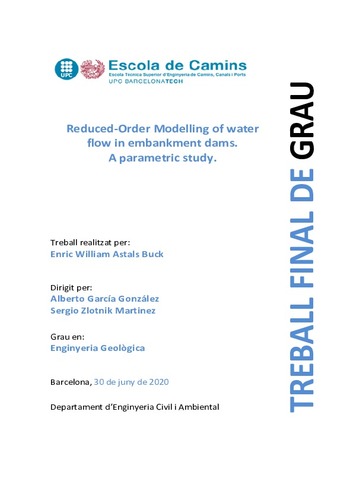Reduced order modelling of water flow in embankment dams. A parametric study

Estadístiques de LA Referencia / Recolecta
Inclou dades d'ús des de 2022
Cita com:
hdl:2117/334595
Correu electrònic de l'autorenricwilliamastalsbuck gmail.com
gmail.com
Tipus de documentTreball Final de Grau
Data2020-06-30
Condicions d'accésAccés obert
Llevat que s'hi indiqui el contrari, els
continguts d'aquesta obra estan subjectes a la llicència de Creative Commons
:
Reconeixement 3.0 Espanya
Abstract
Las presas de relaves son enormes estructuras construidas para almacenar los desechos mineros. En contraposición a las presas de retención de agua, este tipo de estructura es elevada progresivamente a lo largo de su vida útil como respuesta a la productividad de la mina, pudiendo conducir a problemas de estabilidad a largo plazo.
La alta tasa de falla presentada por las presas de relaves es un serio problema en todo el mundo, ocasionando, anualmente, numerosos fallecimientos y la devastación del medio ambiente.
La tecnología de sensores se utiliza hoy en día para monitorizar el estado de presiones y esfuerzos en sus terraplenes, pero debido a que transmiten mediciones locales, tienden a ser difíciles de interpretar.
El trabajo presentado en este documento es una contribución a un proyecto europeo, que está llevando a cabo el diseño de un modelo que, de entrada, recoge datos de los sensores de una presa y, como salida, permite visualizar el estado de esfuerzos y presiones de la estructura entera.
Puesto que las condiciones de riesgo pueden desarrollarse en cuestión de minutos, es necesario que el modelo opere en tiempo real. Para lograrlo, emplea métodos de reducción de modelos, que son empleados para minimizar su tiempo de ejecución.
El documento describe diferentes análisis paramétricos llevados a cabo para entender cómo afectan los métodos numéricos a la precisión del modelo, y establecer cómo deben ser aplicados con tal de maximizar su rendimiento, en un enfoque desacoplado.
Los resultados de las investigaciones permiten conocer bajo qué condiciones la implementación de los métodos beneficia al modelo, y muestran cómo se comporta la exactitud de éste en diferentes circunstancias. Tailings dams are enormous structures built to store the by-products of mining activities. Unlike water-retaining dams, this type of structure is raised gradually throughout its life span, in answer to the productivity of the mine. This can eventually lead to stability problems.
The high failure rate of tailings dams is a major problem across the globe, causing numerous casualties every year and devastating effects from toxic waste on the surrounding environment.
Sensor technology is currently used to monitor the pressure and stress state in their embankments, but as they transmit localised measurements, they are often difficult to interpret.
The work presented in this document serves as a contribution to a European project, which is designing a model that takes sensor data from a tailings dam, and creates a visual display of the pore water pressure and stress state across its entire body.
As hazardous conditions can develop within minutes, the model needs to operate in near real-time. To achieve this, it relies on Reduced-Order Modelling techniques, which are used to minimize its run time.
This document describes different parametric analyses carried out in an attempt to understand how the numerical techniques affect the model’s speed and accuracy, and to establish how they can be applied to improve its performance, in an uncoupled approach.
The results of the investigations determine under which problem conditions the use of Reduced-Order Modelling techniques benefits the model, and show how its accuracy behaves in different circumstances.
TitulacióGRAU EN ENGINYERIA GEOLÒGICA (Pla 2010)
| Fitxers | Descripció | Mida | Format | Visualitza |
|---|---|---|---|---|
| Appendices_TFG_Enric_Astals.zip | 328,6Kb | application/zip | Visualitza/Obre | |
| Memoria_TFG_Enric_Astals.pdf | 3,299Mb | Visualitza/Obre |


